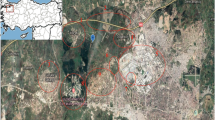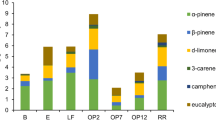Abstract
Diurnal and vertical ambient air measurements of the monoterpenes have been made in and above a Scots pine (Pinus sylvestris) forest of central Sweden, within the boreal northern coniferous biome. Sampling was done with Tenax TA, and analysis by GC and ion trap detection. Daytime mixing ratios were on the order of tenths of a ppbv from the forest floor to the top of the forest, and a factor of 2 or 3 lower above the forest. Mixing ratios at night were at the ppbv level, highest near the forest floor and the crown, and decreased with height above the forest. The highest total concentration observed was 8 ppbv inside the forest at 3 am (GMT). The average terpene composition was 3-carene 32%, α-pinene 29%, limonene 18%, β-pinene 10%, β-phellandrene 7%, camphene 5%, and sabinene at less than 2%. The 3-carene/α-pinene ratio varied with wind direction and speed, relative humidity, and wet/dry vegetation, but not with ozone or NO2 concentration, solar radiation, or temperature. Variations in the observed terpene composition at the sampling site are mainly caused by the influence of other vegetation in the vicinity of the site. It would seem that wet Scots pine emits more 3-carene relative to α-pinene than does dry pine.
Similar content being viewed by others
References
Altshuller A. (1983) ‘Review: Natural Volatile Organic Substances and Their Effect on Air Quality in the United States’, Atmos. Environ. 17, 2131–2165.
Atkinson R. Aschmann S., and Arey J. (1990) ‘Rate Constants for the Gas-Phase Reactions of OH and NO3 Radicals and O3 with Sabinene and Camphene at 296±2 K’, Atmos. Environ. 24A, 2647–2654.
Axelsson, B. and Bråkenhielm, S. (1980) ‘Investigation sites of the Swedish Coniferous Forest Project: biological and physiographical features’, in T. Persson (ed.) Structure and Function of Northern Coniferous Forests-An Ecosystem Study, Ecol. Bull. 32, Stockholm, 11–23.
Holdren M., Westberg H. and Zimmerman P. (1979) ‘Analysis of Monoterpene Hydrocarbons in Rural Atmospheres’, J. Geophys. Res. 84:C8, 5083–5088.
Hov O., Schjoldager J. and Wathne B. (1983) ‘Measurement and Modeling of the Concentrations of Terpenes in Coniferous Forest Air’, J. Geophys. Res. 88:C15, 10679–10688.
Isidorov V., Zenkevich I., and Ioffe B. (1985) ‘Volatile Organic Compounds in the Atmosphere of Forests’, Atmos. Environ. 19, 1–8.
Janson R. and Kristensson J. (1991) ‘Sampling and Analysis of Atmospheric Monoterpenes’, Report CM-79, Department of Meteorology, Stockholm University, S-106 91 Stockholm, Sweden.
Juuti S., Raunemaa T. and Ruuskanen J. (1990) ‘Measurements of Monoterpenes in a Coniferous Forest’, in H. Ross (ed.), Proc. Nordic Sym. Atm. Chem., Dec. 6–8, 1989, Report CM-78, Dept. Meteorology, Stockholm University, Sweden.
Lamb B., Westberg H., Allwine G., and Quarles T. (1985) ‘Biogenic Hydrocarbon Emissions from Deciduous and Coniferous Trees in the United States’, J. Geophys. Res. 90:D1, 2380–2390.
Petersson G. (1988) ‘High Ambient Concentrations of Monoterpenes in Scandiavian Pine Forests’, Atmos. Environ. 22:11, 2617–2619.
Riba M., Tathy J., Tsiropoulos N., Monsarrat B., and Torres L. (1987) ‘Diurnal Variation in the Concentration of alpha- and beta-pinene in the Landes Forest (France)’, Atmos. Environ. 21, 191–193.
Roberts J., Fehsenfeld F., Albritton D., and Sievers F. (1983) ‘Measurement of Monoterpene Hydrocarbons at Niwot Ridge, Colorado’, J. Geophys. Res. 88:C15, 10667–10678.
Roberts J., Hahn C., Fehsenfeld F., Warnock J., Albritton D. and Sievers R. (1985) ‘Monoterpene Hydrocarbons in the Nighttime Troposphere’, Environ. Sci. Technol. 19, 364–368.
Shaw R.Jr., Crittenden A., Stevens R., Cronn D., and Titov V. (1983) ‘Ambient Concentrations of Hydrocarbons from Conifers in Atmospheric Gases and Aerosol Particles Measured in Soviet Georgia’, Environ. Sci. Technol. 17, 389–395.
Steinbrecher, R., (1990) ‘Gehalt und Emission von Monoterpenen in oberirdischen Organen von Picea Abies (L.) Karst’, Dissertation Thesis, Institut fur Botanik und Mikrobiologie, Lehrstuhl fur Botanik der Technischen Universität Munchen (in German).
Wikström A. (1989) ‘Climatic and Environmental Measurements at Jädraås Research Station 1983–1986’, Report 35, Dept. of Ecology and Environmental Research, Swedish Univ. of Agricultural Sciences, Uppsala, Sweden, (in Swedish).
Yokouchi Y., Okaniwa M., Ambe Y. and Fuwa K. (1983) ‘Seasonal Variation of Monoterpenes in the Atmosphere of a Pine Forest’, Atmos. Environ. 17:4, 743–750.
Yokouchi Y. and Ambe Y. (1988) ‘Diurnal Variations of Atmospheric Isoprene and Monoterpene Hydrocarbons in an Agricultural Area in Summertime’, J. Geophys. Res. 93:D4, 3751–3759.
Author information
Authors and Affiliations
Rights and permissions
About this article
Cite this article
Janson, R. Monoterpene concentrations in and above a forest of scots pine. J Atmos Chem 14, 385–394 (1992). https://doi.org/10.1007/BF00115246
Published:
Issue Date:
DOI: https://doi.org/10.1007/BF00115246




